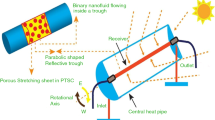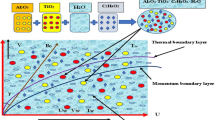Abstract
In this work an experimental study on Silver-oil nanofluid was carried out in order to present the laminar convective heat transfer coefficient and friction factor in a concentric annulus with constant heat flux boundary condition. Silver-oil nanofluid prepared by Electrical Explosion of Wire technique with no nanoparticles agglomeration during nanofluid preparation process and experiments. The average sizes of particles were 20 nm. Nanofluids with various particle Volume fractions of 0.011, 0.044 and 0.171 vol% were employed. The nanofluid flowing between the tubes is heated by an electrical heating coil wrapped around it. The effects of different parameters such as flow Reynolds number, tube diameter ratio and nanofluid particle concentration on heat transfer coefficient are studied. Results show that, heat transfer coefficient increased by using nanofluid instead of pure oil. Maximum enhancement of heat transfer coefficient occurs in 0.171 vol%. In addition the results showed that, there are slight increases in pressure drop of nanofluid by increasing the nanoparticle concentration of nanofluid in compared to pure oil.















Similar content being viewed by others
Abbreviations
- f :
-
Darcy–Weisbach friction factor
- k :
-
Thermal conductivity (W/m K)
- c p :
-
Specific heat (J/kg K)
- D :
-
Round tube diameter (m)
- D h :
-
Concentric annular tube hydraulic diameter (m)
- h :
-
Convective heat transfer coefficient (W/m2 K)
- \(\bar{h}\) :
-
Mean convective heat transfer coefficient (W/m2 K)
- L :
-
Length of the tube (m)
- Nu :
-
Nusselt number
- P :
-
Tube cross section perimeter (m)
- Pe :
-
Peclet number
- q″ :
-
Heat flux (W/m2)
- T :
-
Temperature (K)
- Re :
-
Reynolds number
- X :
-
Distance from entrance of tube (m)
- \(\Delta P\) :
-
Pressure drop along the test section (Pa)
- µ:
-
Dynamic viscosity (Pa.s)
- ρ:
-
Density (kg/m3)
- ψ :
-
Weight concentration
- bf :
-
Base fluid
- nf :
-
Nanofluid
- I :
-
Inlet
- m :
-
Mean fluid bulk temperature
- s :
-
Surface
References
Bergles AE (1973) Recent development in convective heat transfer augmentation. Appl Mech Rev 26:675–682
Thome JR (2004) Engineering Data Book III, Wolverine Tube, Inc
Xuan Y, Li Q (2003) Investigation on convective heat transfer and flow features of nanofluids. J Heat Transfer 125(1):151–155
Duangthongsuk W, Wongwises S (2010) Comparison of the effects of measured and computed thermophysical properties of nanofluids on heat transfer performance. Exp Thermal Fluid Sci 34:616–624
Lee S, Choi SUS, Li S, Eastman JA (1999) Measuring thermal conductivity of fluids containing oxide nanoparticles. J Heat Transfer 121:280–289
Lai WY, Duculescu B, Phelan PE, Prasher RS (2006) Convective heat transfer with nanofluids in a single 1.02-mm tube, Proceedings of ASME International Mechanical Engineering Congress and Exposition (IMECE).pp 65-76
Kim D, Kwon Y, Cho Y, Li C, Cheong S, Hwang Y et al (2009) Convective heat transfer characteristics of nanofluids under laminar and turbulent flow conditions. Curr Appl Phys 9(2):119–123
Yang Y, Zhang Z, Grulke E, AndersonW WuG (2005) Heat transfer properties of nanoparticles-in-fluid dispersions (nanofluids) in laminar flow. Int J Heat Mass Transf 48(6):1107–1116
Palm SJ, Roy G, Nguyen CT (2004) Heat transfer enhancement in radial flow cooling system-using nanofluid. in: Proceeding of the ICHMT International symposium on advance computational heat transfer, Norway, CHT-04, 110–121
Meyer JP, McKrell TJ, Grote K (2013) The influence of multi-walled carbon nanotubes on single-phase heat transfer and pressure drop characteristics in the transitional flow regime of smooth tubes. Int J Heat Mass Transf 58:597–609
Saha SK, Langille P (2002) Heat transfer and pressure drop characteristics of laminar flow through a circular tube with longitudinal strip inserts under uniform wall heat flux. J Heat Transfer 124:421–432
Roy G, Nguyen CT, Lajoie PR (2004) Numerical investigation of laminar flow and heat transfer in a radial flow cooling system with the use of nanofluids. Superlattices Microstruct 35:497–511
Sarma PK, Kedarnath Ch, Sharma KV, Sundar LS, Kishore PS, Srinivas V (2010) Experimental study to predict momentum and thermal diffusivities from convective heat transfer data of nano fluid with Al2O3 dispersion. Int J Heat Technol 28:123–131
Kaka CS, Pramuanjaroenkij A (2009) Review of convective heat transfer enhancement with nanofluids. Int J Heat Mass Transf 52:3187–3196
Liu C, Yang X, Yuan H, Zhou Z, Xiao D (2007) Preparation of silver nanoparticle and its application to the determination of ct-DNA. Sensors 7:708–718
Razi P, Akhavan-Behabadi MA, Saeedinia M (2011) Pressure drop and thermal characteristics of CuO–base oil nanofluid laminar flow in flattened tubes under constant heat flux. Int Commun Heat Mass Transf 38:964–971
Alqudami A, Annapoorni S, Shivaprasad Govind SM (2007) Ag–Au alloy nanoparticles prepared by electro-exploding wire technique. J Nanopart Res. doi:10.1007/s11051-007-9333-4
Tien DC, Liao CY, Huang JC, Tseng KH, Lung JK, Tsung TT, Kao WS, Tsai TH, Cheng TW, Yu BS, Lin HM, Stobinski L (2008) Novel technique for preparing a nano-silver water suspension by the arc-discharge method. Rev Adv Mater Sci 18:750–756
Coleman HW, Steele WG (1989) Experimental and uncertainty analysis for engineers. Wiley, New York
Fakoor Pakdaman M, Akhavan-Behabadi MA, Razi P (2012) An experimental investigation on thermo-physical properties and overall performance of MWCNT/heat transfer oil nanofluid flow inside vertical helically coiled tubes. Exp Therm Fluid Sci 40:103–111
Anoop KB, Sundararajan T, Das SK (2009) Effect of particle size on the convective heat transfer in nanofluid in the developing region. Int J Heat Mass Transf 52:2189–2195
Wen D, Ding Y (2004) Experimental investigation into convective heat transfer of nanofluids at the entrance region under laminar flow conditions. Int J Heat Mass Transf 47:5181–5188
Fotukian SM, Nasr Esfahany M (2010) Experimental investigation of turbulent convective heat transfer of dilute Al2O3-water nanofluid inside a circular tube. Int J Heat Fluid Flow 31:606–612
Duangthongsuk W, Wongwises S (2009) Heat transfer enhancement and pressure drop characteristics of TiO2–water nanofluid in a double-tube counter flow heat exchanger. Int J Heat Mass Transf 52:2059–2067
Duangthongsuk W, Wongwises S (2010) An experimental study on the heat transfer performance and pressure drop of TiO2-water nanofluids flowing under a turbulent flow regime. Int J Heat Mass Transf 53:334–344
He Y, Jin Y, Chen H, Ding Y, Cang D, Lu H (2007) Heat transfer and flow behaviour of aqueous suspensions of TiO2 nanoparticles (nanofluids) flowing upward through a vertical pipe. Int J Heat Mass Transf 50:2272–2281
Kays WM, Crawford ME, Weigand B (2005) Convective heat and mass transfer, Fourth ed., Mc Grow Hill, pp. 104–105 and pp. 330–335
Chen H, Yang W, He Y, Ding Y, Zhang L, Tan C, Lapkin AA, Bavykin DV (2008) Heat transfer behavior of aqueous suspensions of titanate nanofluids. Powder Technol 183:63–72
Buongiorno J, Venerus CD, Prabhat N, McKrel lT, Townsend J, Christianson R et al (2009) A benchmark study on the thermal conductivity of nanofluids. J Appl Phy 106:1–14
Farajollahi B, Etemad SGH, Hojjat M (2010) Heat transfer of nanofluids in a shell and tube heat exchanger. Int J Heat Mass Transf 53(1–3):12–17
Webb RL, Eckert ERG (1972) Application of rough surfaces to heat exchanger design. Int J Heat Mass Transf 15(9):1647–1658
Boer KW (1978) Payback of solar systems. Sol Energy 20:225–232
Altfeld K, Leiner W, Fiebig M (1988) Second law optimization of flat-plate solar air heaters—part I: the concept of net exergy flow and themodeling of solar air heaters. Sol Energy 41(2):127–132
Cort´es A, Piacentini R (1990) Improvement of the efficiency of a bare solar collector by means of turbulence promoters. Appl Energy 36(4):253–261
Wang L, Sunden B (2007) Experimental investigation of local heat transfer in a square duct with various-shaped ribs. Heat Mass Transf 43(8):759–766
Thianpong C, Eiamsa-ard P, Eiamsa-ard S (2012) Heat transfer and thermal performance characteristics of heat exchanger tube fitted with perforated twisted-tapes. Heat Mass Transf 48(6):881–892
D’Agaro P, Comini G (2008) Thermal-performance evaluation of coolant passages with staggered arrays of pin fins. Heat Mass Transf 44(7):815–825
Elsayed ML, Mesalhy O (2014) Studying the performance of solid/perforated pin-fin heat sinks using entropy generation minimization. Heat Mass Trans 1–12
Buongiorno J (2006) Convective transport in nanofluids. J Heat Transfer 128(3):240–250
Wen DS, Ding YL (2005) Effect on heat transfer of particle migration in suspensions of nanoparticles flowing through minichannels. Microfluid Nanofluid 1(2):183–189
Author information
Authors and Affiliations
Corresponding author
Rights and permissions
About this article
Cite this article
Abbasian Arani, A.A., Aberoumand, H., Aberoumand, S. et al. An empirical investigation on thermal characteristics and pressure drop of Ag-oil nanofluid in concentric annular tube. Heat Mass Transfer 52, 1693–1706 (2016). https://doi.org/10.1007/s00231-015-1686-0
Received:
Accepted:
Published:
Issue Date:
DOI: https://doi.org/10.1007/s00231-015-1686-0




